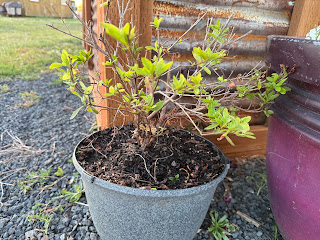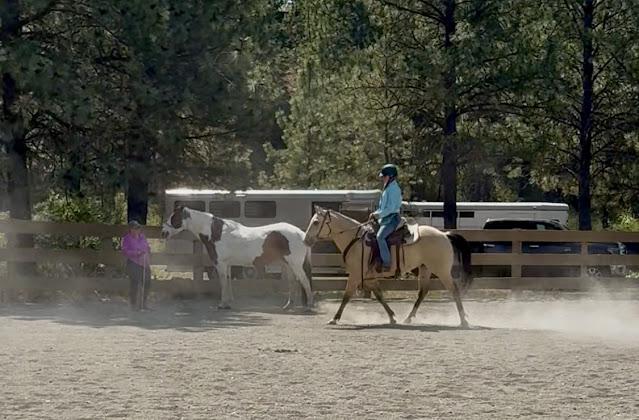My husband and I made it to the equestrian area with our horses. It was Day 2 ‘back in saddle’ for Leah. I would say it went worse for her, but better for Tumbleweed
When we started off on the ground at the obstacle course, Leah was the rock star.
Teeter Totter
I loved watching them together. Leah had the sweetest eye for him.
In saddle, however, the roles reversed, and it was Tweed who was the rockstar, and Leah wanted to pick up speed (and ignore my husband) back to the trailer.
This led to a mini-lesson on trail work. I’ll try to recap what I told my husband, and feel free to offer your own insights in the comments.
First off, riding a horse on a straight line with a loose rein is the pinnacle of trail riding. It’s the goal. It rewards both them and us.
However, it also takes a lot of personal responsibility from the horse who would prefer to take control and run the hell back home. It’s unnatural and uncomfortable for them to leave the herd and wander down a dark trail. It goes against all their survival instincts.
I start out on a loose rein, but I look for signals that they’re still with me. Where are their ears pointing? How fast are they walking?
I ‘check in’ with my horse to see if they’re in the thinking part of their brain. The first check in is a light tug on the right or left side of the mouth. If I get an ear that means I still have light communication.
If Yes, I proceed down the trail on a loose rein.
If no, I pick up the reins for contact. If they’ve changed the speed, I ask for the speed I want.
Same questions, and it’s all happening super fast. Do I get an ear? Do they check their speed?
If yes, we go back to a loose rein and proceed.
If it’s a no, as in no ear and no checked speed, I give them a job.
My goal is to always, and I mean always, keep them tuned in and thinking. Every single time I cut a corner and thought, oh, you’re being too nit picky, it has bit me in the butt with something bigger happening.
I told my husband that pulling on the reins alone dams up the energy, and it is going to explode. They’re not trying to be mean, or even disrespectful, they’ve just switched into flight mode for survival and, unless we can bring them back to the thinking, non-reactive side of the brain, we will see an explosion of that energy in a jump, buck, rear, head shaking, kicking, or run away.
I also told my husband that if all else fails and you cannot get them in a working frame of mind, they usually give you a few seconds to dismount with a one rein stop, and there is no harm in that. In fact, it can be a much better option. Not a great one, because they will remember it, but better than some other alternatives.
I broke the news to my husband: hey, we’re probably not going to make it very far down the trail tonight, and that’s okay. We’re going to take the time and do it right. If we need to stop and give them a job, it’s okay. They have to know this isn’t a straight line RACE track. It’s a job that they’re doing with us. It’s unpredictable and they need to stay connected to the human leader and be ready for whatever we ask. No auto pilot allowed. (This is why I have ridden alone in the past. It’s a lot to ask of a friend to sit and watch you school the trails. My husband, however, is happy to do it.)
Off we went. I tried to stay behind to keep an eye on hubby and Leah, but it wasn’t too long and we were riding separately through trees, going our own way and doing a “job.”
At one point, I could barely see Leah, and T was still tuned into me and the work. BIG WIN. I was guiding him in circles, around trees, through brush, up and down little hills, and he was paying attention to his feet and the light contact.
We were in saddle for an hour and a half, and it was all fun work.
Afterwards, as we sat and had wine at the trailer and let the horses rest, I reflected on riding the trails with Leah, who has had so much time off, versus a more solid trail horse. I kind of like it. As I watch my husband try to figure it out, all the things my trainer taught me make more sense. It’s so hard to see what she’s saying when it’s me struggling. But a very bright lightbulb went off watching my husband go through it.
Also, there is good and bad to following a steady Eddie down the trail. It is easier to follow, but we also want them to be independent. What I saw from Tweed when he couldn’t see Leah (and didn’t look for her) was that budding independence I’ve been working so hard to foster.
I love this work with my boy. Truly, it’s how heart horses are made. I can see it happening with Leah and my husband, too. MYEI Make You Earn It types. (I wrote about the different types on Gun Divas blog, years ago, as a guest post.)
As we talked, my husband said how much he enjoyed it, too. He said he could do this kind of trail work for the rest of the summer and be totally happy.
That’s good, because I don’t want to put a time limit on setting a solid trail foundation. Every journey is totally unique to the horse and rider.
And it’s all about that journey, not the destination.
Extra credit:
This is my trail training in stick figures:
Figure (A) says Kentucky Derby, Preakness and Belmont wrapped into one. First horse around the loop and back to the trailer wins the triple crown. All you need is someone to shoot off a gun and open the gates.
Figure (B) says we don’t know where we’re going, maybe into the woods, maybe back home, but we sure like walking around trees. Ultimately, the trees, “the work,” are the destination.
















































